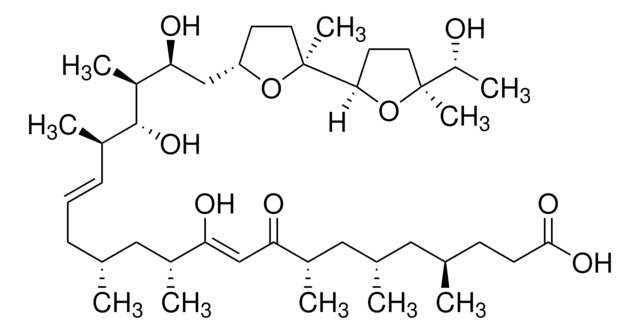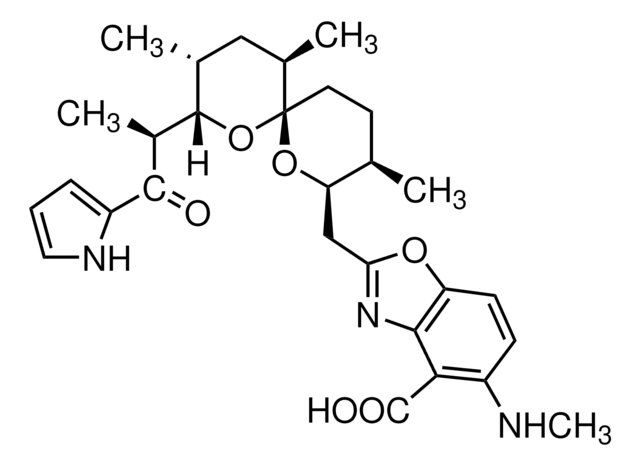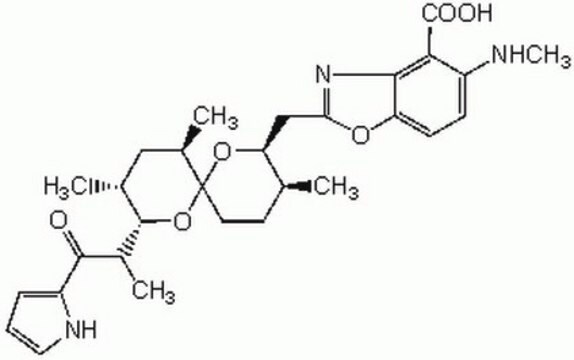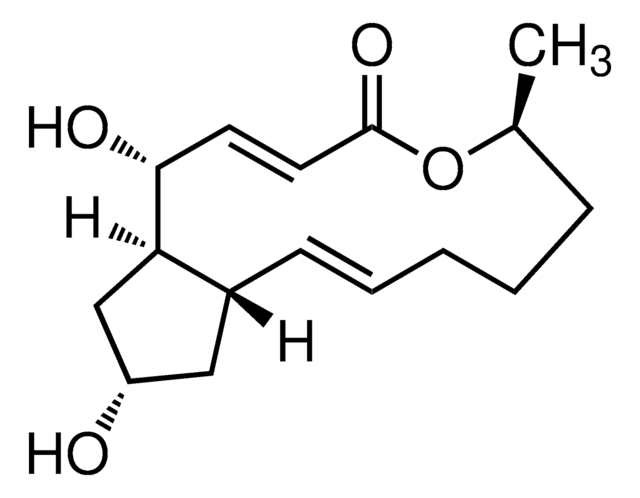I3909
Ionomycin calcium salt
Ready Made Solution, from Streptomyces conglobatus, 1 mM in DMSO
Synonym(s):
Calcium Ionophore Ionomycin
About This Item
Recommended Products
biological source
Streptomyces conglobatus
Quality Level
Assay
≥98% (HPLC)
shelf life
2 yr
storage condition
(Tightly closed. )
concentration
1 mM in DMSO
color
colorless
mp
18.4 °C
solubility
DMSO: 1 mM
antibiotic activity spectrum
Gram-positive bacteria
Mode of action
cell membrane | interferes
shipped in
wet ice
storage temp.
−20°C
SMILES string
C[C@@H]1CCC(=O)O[Ca]OC(=CC(=O)[C@@H](C)C[C@@H](C)C1)[C@H](C)C[C@H](C)C\C=C\[C@@H](C)[C@@H](O)[C@@H](C)[C@@H](O)C[C@@H]2CC[C@](C)(O2)[C@H]3CC[C@](C)(O3)[C@@H](C)O
InChI
1S/C41H72O9.Ca/c1-25(21-29(5)34(43)24-35(44)30(6)22-27(3)20-26(2)14-15-38(46)47)12-11-13-28(4)39(48)31(7)36(45)23-33-16-18-41(10,49-33)37-17-19-40(9,50-37)32(8)42;/h11,13,24-33,36-37,39,42-43,45,48H,12,14-23H2,1-10H3,(H,46,47);/q;+2/p-2/b13-11+,34-24-;/t25-,26-,27+,28-,29-,30+,31+,32-,33+,36+,37-,39-,40+,41+;/m1./s1
InChI key
WKRWUYKLUMMAKG-WYGBAUISSA-L
General description
Ionomycin is commonly used in cell biology experiments to induce a rapid and controlled increase in intracellular calcium levels. This allows to study the downstream effects of calcium signaling pathways, such as the activation of enzymes, the release of hormones, and the changes in gene expression.Ionomycin is also used to investigate the role of calcium in specific cellular processes, such as cell death, immune cell activation, and muscle contraction. For example, ionomycin can be used to induce apoptosis in cancer cells, study the activation of T cells, and investigate the role of calcium in muscle contraction.
Application
- Study of calcium signaling and its role in various biological processes
- Investigation of intracellular calcium levels, calcium-dependent enzymes, and cellular responses triggered by calcium influx
- Induction of a rapid and controlled increase in intracellular calcium levels in cell biology experiments
- Elucidation of specific cellular mechanisms and signaling pathways in combination with other substances, such as fluorescent calcium indicators or protein kinase activators
- to induce central demyelination
- inhibit adrenal bovine TREK-1 channels
- to regulate cell division of mature human B cells
Biochem/physiol Actions
Mode of Action: Facilitates the transfer of calcium ions (Ca2+) across biological membranes
Antimicrobial Spectrum: Active against Gram-Positive bacteria
Features and Benefits
- Ready available solution reduce the need for preparation time
- Efficient choice for studying calcium signaling and its role in various biological processes
- Allows for rapid and controlled manipulation of intracellular calcium levels
- Versatile and widely used in cell biology research
Other Notes
Storage Class Code
10 - Combustible liquids
WGK
WGK 1
Flash Point(F)
188.6 °F - closed cup
Flash Point(C)
87 °C - closed cup
Personal Protective Equipment
Regulatory Listings
Regulatory Listings are mainly provided for chemical products. Only limited information can be provided here for non-chemical products. No entry means none of the components are listed. It is the user’s obligation to ensure the safe and legal use of the product.
FSL
Group 4: Flammable liquids
Type 3 petroleums
Hazardous rank III
Water insoluble liquid
JAN Code
I3909-1ML-PW:
I3909-VAR:
I3909-BULK:
I3909-1ML:
Certificates of Analysis (COA)
Search for Certificates of Analysis (COA) by entering the products Lot/Batch Number. Lot and Batch Numbers can be found on a product’s label following the words ‘Lot’ or ‘Batch’.
Already Own This Product?
Find documentation for the products that you have recently purchased in the Document Library.
Customers Also Viewed
Our team of scientists has experience in all areas of research including Life Science, Material Science, Chemical Synthesis, Chromatography, Analytical and many others.
Contact Technical Service











